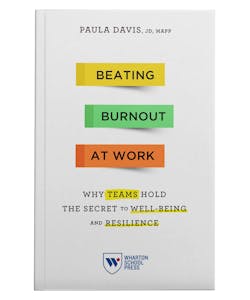Burnout Isn't Just an Employee Issue — It's a Workplace Issue
Burnout is a manifestation of chronic workplace stress.
“We view burnout as an individual’s issue, but the real problem is that something is out of balance in the workplace,” explains Paula Davis, founder of the Stress and Resilience Institute. “It boils down to too many job demands and too few job resources.”
Burnout is a systemic issue that is based on a variety of factors. “It’s influenced by how leaders conduct themselves as well as how people interact within a team,” says Davis. Of course, organizations are also under stress from a variety of sources which include regulations, financial and market conditions. So, the goal is to have a holistic approach to viewing an organization and its interactions and then alleviating burnout.
First, it’s important to understand the drivers of burnout. From Davis’ research she has found these three causes:
High Workload
This is the most common problem, people have too many responsibilities and not enough resources. And they are told that there are no resources to hire more people. While this is a complicated issue, an organization has to understand and address this in a manner that provides some relief.
Lack of Recognition
While each generation desires different levels of recognition all need some form of recognition. This aspect needs to have a lot more attention than it has been given in the past, Davis notes.
Lack of Support
Psychological safety is often the foundation of both resilience and high performance. “The essence of this concept is that a level of trust must be established in a team so that employees feel that they can share information, especially innovative ideas, in a space where respect is the cornerstone,” says Davis. This concept is the foundation upon which teams can build positive cultures, notes Davis.
Having healthy teams creates an atmosphere that fosters both acceptance and transparency, which can greatly reduce stress. “When your team isn’t cohesive, it can be very exhausting,” says Davis.
As is always the case, measurement is a key to understanding a problem and that holds true for determining whether burnout is a problem in an organization. Employers should have an assessment of the current state of their workforce’s stress levels, advises Davis. And to help employers with designing assessments, she includes samples in her new book, “Beating Burnout at Work: Why Teams Hold the Secret to Well-Being and Resilience.”
In her book, she offers case studies of companies that created successful strategies to overcome burnout. “The organizations that are successful in addressing burnout end up building a resilient, thriving, and engaged workplace.”

